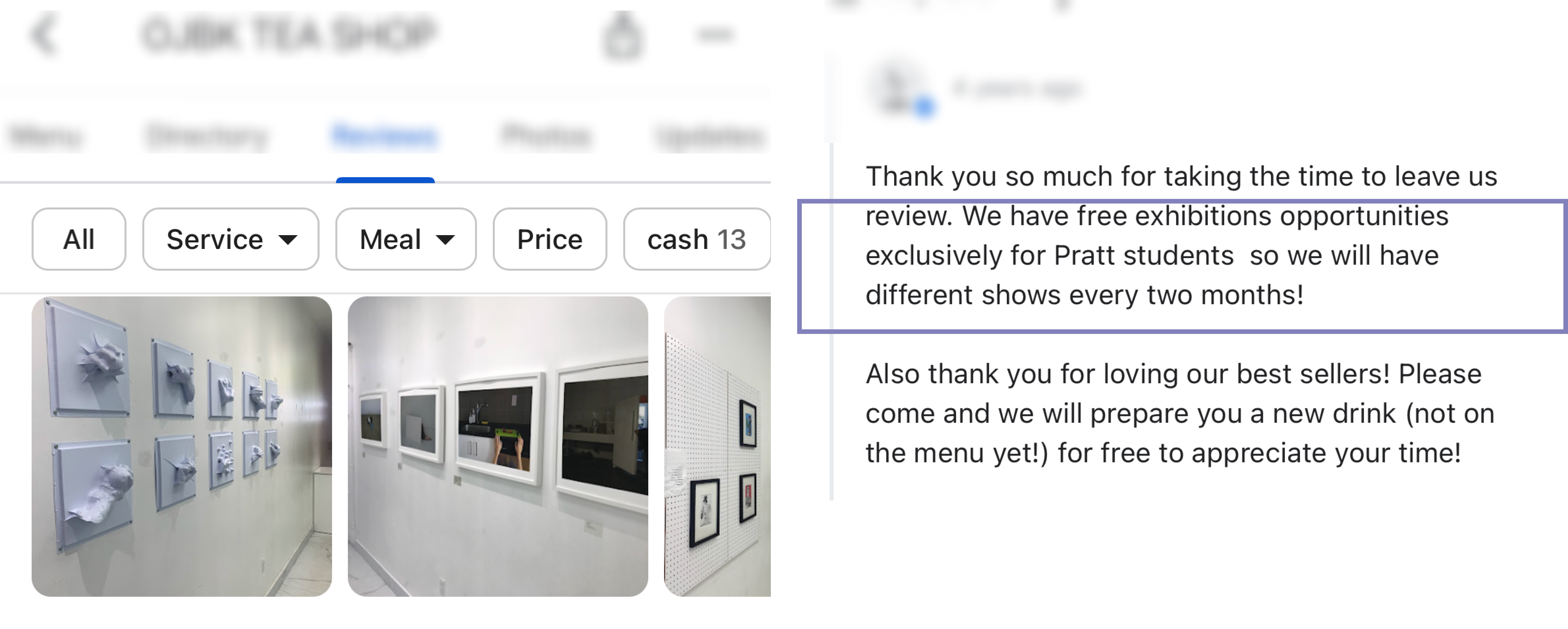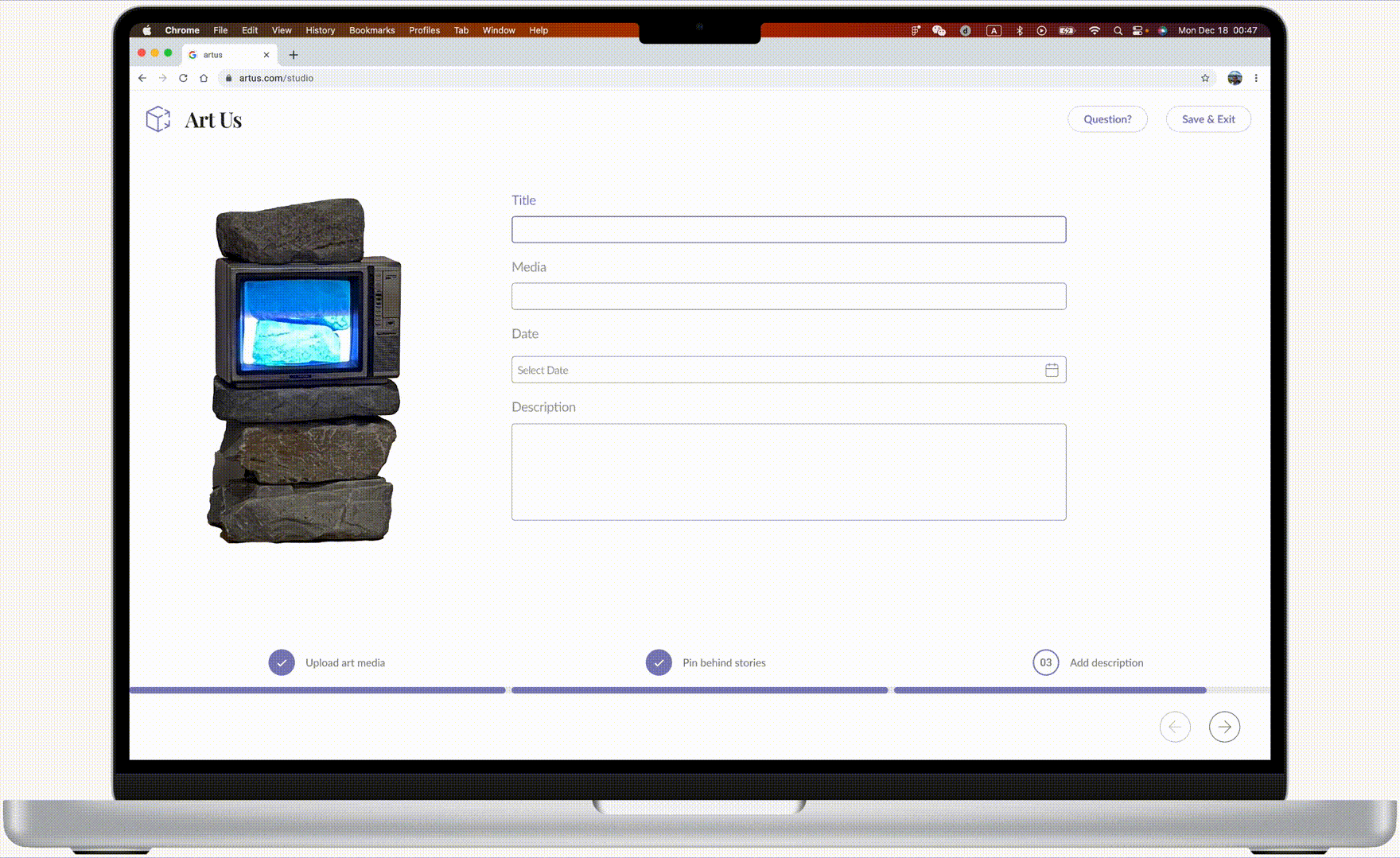
Artus, an Innovative Win-Win Ecosystem connected
Local Business, Artists and Customers.
DURATION
2023.11-2023.12
CHALLENGE FROM
Clinton Hill Artists Community
MY ROLE
UX Researcher and Designer
PROBLEM
Clinton Hill, home to Pratt Institute, has attracted many young artists, infusing the neighborhood with fresh energy and vitality. However, more and more artists are now being forced to leave. For them, making a living from original artworks is a significant challenge.
New York’s art market is highly competitive, and independent creators often face obstacles such as low visibility and limited marketing resources.
FINAL SERVICE DESIGN

INTERVIEW
Why the rising artists can’t make a living on their original artworks? How do successful artists sell their artworks? To gain deeper insights into artists' current situations, we began by conducting interviews with 10 rising artists and 5 successful artists.
FINDINGS
This is a common misconception. While successful artists can sell their work through auctions, galleries, art fairs, or even their own studios, emerging artists often struggle to even get their art into galleries or online platforms. These avenues typically require high entry fees and demand a certain level of recognition from the artist.
Why not social media?
Followers may appreciate the art, but that doesn't necessarily mean they are ready to purchase it. Additionally, social media algorithms favor engagement over transactions, leading to "likes" without actual sales.
Just when we thought there was no way forward, a new voice emerged. After interviewing some well-known artists in Williamsburg (another district located in Brooklyn), the idea of leveraging local communities as a means to promote and sell artwork caught my attention.
Selling artwork locally is convenient for shipping. Also, it is easier for customers to get a “preview” of the art before commitment.
DESIGN QUESTION
Therefore, We have defined the design question:

SOCIAL LISTENING
Through social listening on the community social media, we found that local market exists but customers lack ways to connect with artists.

CONTEXTUAL INQUIRIES
Based on the previous interview findings and social listening insights, we conducted a case study research in the Clinton Hill Community to better understand the local market.
We visited 10+ local business in the neighborhood and interviewed 7 art customers to find answers of these questions:
What is “local network”?
How does it connect the artist and their customers?
What factors influence local customers' decision whether to purchase artworks?
FINDINGS
![]()
We conducted contextual inquires at surrounding cafe and local shops.
I visited 10+ shops, scheduled interviews with their owners and found that
- For artists, a large number of potential consumers visit these local businesses such as cafes, drink shops, etc. Unused corners and walls in these shops can potentially work as exhibition spaces.

- For local businesses, their customers care about the appearances and vibes of the places. After interviewing 20 business owners, they are willing to provide free exhibition opportunities for the Pratt art students trading for better reputations and attractive interior decorations.

To sum up, displaying artwork at local businesses will be a win-win for both local businesses and artists.
Affordable art merch is the more accessible first step among art consumers.
Understanding the stories and processes behind an art piece is the next step before buying original art.
IDEATION
Therefore, we ideate a way that artists and customers can meet at local business, encounter, explore, learn and finally purchase.

SERVICE BLUEPRINT
What we can do to create a bridge between them? To better demonstrate the interactions between artists, local businesses and customers on each stage, we synthsized a service blueprint.
STORYBOARD
AR DESIGN CHALLENGE
Design Goals & User Goals
- Enable artists to easily capture their artwork in 3D/AR format and add personal stories or background details.
- Allow business owners to visualize and test how the artwork would look within their environment to make informed collaboration decisions.
- Provide customers with an immersive experience to explore and learn about the story behind each artwork.
Comparative Analysis
Guided Scanning Process: Use visual cues such as arrows or grid overlays and offer real-time feedback to guide users as they scan objects from different angles, ensuring a complete and accurate capture.
AR Object Placement and Interaction: Allow users to select scanned models and place them within their surroundings, offering a realistic preview of how the objects would appear in real-world settings.
Based on the current goals and competitive analysis, we have created Low-Fi prototypes of how users use their phones to scan the artwork:
During the usability evaluation, we found that artists are hard to realize when the capture work is finished, so we changed the normal camera button to a clock animated button, artists can track the progress.
While in this process, we found that some of the artists may wanna add the stories and details directly when they finished the 3D scanning. Therefore, we add an extra step that allows users to pin and edit their 3D models before uploading to the laptop.
SHOWCARD DESIGN CHALLENGE
Design Goal
- Enable artists to swiftly create professional print materials aligned with industry best practices.
FINAL PRESENTATION
Scenario 1: Upload Artwork
Step1: Artist saw the poster of ArtUs, and decided to give a try. She click the link to open the ArtUs website and start uploading her artworks. Key features: 3D Capture covert to AR model, Multimedia submission of description and stories

Artist pinned behind stories to the artwork AR and scan the QR code to check the preview on their phone.

After uploading, artist added descriptions and way to publish.

Step 2: After that, artist saw the print options and decided to order some showcards to promote her works with local cafes.
Key features: Design prints for artwork promotion, Order Prints

We have not published the final 2 scenes’ prototypes but here’re our envision to the scenario 2 and 3.
Scenario 2: Collaborate with Local Business
Step 1: Calyer’s cafe got the Showcard from artist, they scanned the QR code on the showcard and test AR effect in their shop. They found it fit really well, and they decided to send the collaborate request to the Artist.
Key features: AR preview, Collaboration Request
Step 2: Artist received the collaborate request from Calyer’s cafe and choose the available slots for delivery.
Key features: Request Email, Collaboration Schedule and Details
Key features: Request Email, Collaboration Schedule and Details
Scenario 3: Sell artwork to customer
Jamie saw the installation at the Calyer’s, she scanned the QR code on the side to explore AR stories of the artwork and decided to purchase.
Key features: Overlay Information in AR, Order Artwork
